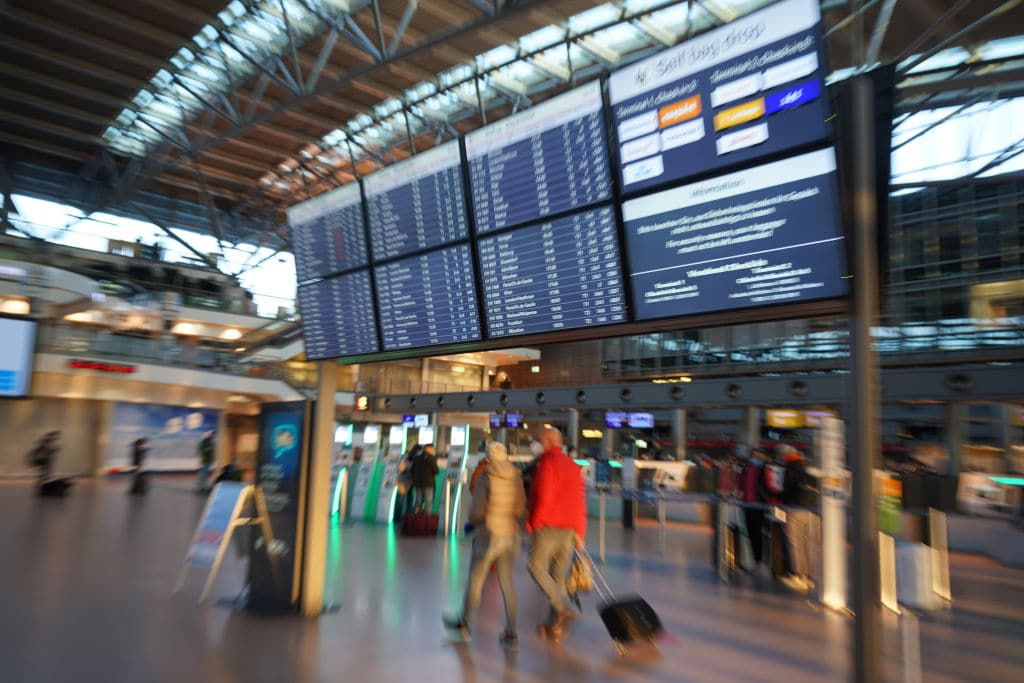On JetBlue Airways’ third-quarter earnings call on Tuesday, in which the company reported its first pandemic profit of $57 million, executives repeatedly cited air traffic control staffing challenges as an ongoing issue.
JetBlue’s president Joanna Geraghty characterized the air-traffic-control environment as “fragile” and “constrained” while commending the agency for being “a great partner, bringing a ton of transparency around what they’re seeing in terms of staffing challenges.”
The airline’s CFO, Ursula Hurley, said the airline was operating in a “challenging environment throughout the network, given ATC delays.”
On Wednesday, airports around the world tallied more than 14,000 flight delays and 2,600 cancellations, according to FlightAware tracking data. In the United States, four airports saw at least 20% of their flights delayed.
That’s a significant improvement from this past summer, which saw more than 20,000 flights delayed every day worldwide. During those months, it was typical to see up to 20 U.S. airports a day with more than 20% of their scheduled flights delayed. Industry analysts have chalked up the vast majority of those delays to a widespread pilot shortage.
Loading...
Yet the airlines have also pointed fingers at the FAA. Last April, officials at JetBlue, Southwest and Spirit charged that staffing issues at the Federal Aviation Authority’s center in Jacksonville, Florida, had led to delays and cancellations to thousands of Florida bound flights. Just before the July 4th holiday weekend, Delta Air Lines CEO Ed Bastian suggested that a “stressed” air traffic control was the leading cause of flight disruptions in the U.S.
Last month at the Global Aerospace Summit, United Airlines CEO Scott Kirby told CNN that the air traffic controller shortage was the carrier’s top concern. “It was tight before the pandemic and they don’t have enough people today and they need more,” he said.
The FAA has repeatedly suggested that airlines should get their own houses in order.
“Airlines should focus on restoring customers’ faith by being transparent about the cause of interruptions and by delivering what they promise,” said the FAA in a statement provided to Forbes. “Airline data show that the vast majority of delays are not from air traffic controller staffing.”
That is true. In the first eight months of 2022, U.S. airlines reported 951,181 delayed flights, or nearly 119,000 per month, to the Department of Transportation. Of those, airlines attributed 40% of delays to the carriers themselves compared to 17% attributable to the national aviation system.
Another 37% flights were delayed due to aircraft arriving late to departure gates. But again, the airlines themselves attributed 63% of those delays to the carriers compared to 10% blamed on the national aviation system.
“The agency is investing significant resources to eliminate the Covid training backlog and continues hiring a new, more diverse generation of controllers to meet demand as air travel increases,” said the FAA.
The median pay for an air traffic controller is $129,750 per year — about four times higher than the median for all occupations in the U.S., according to the U.S. Bureau of Labor Statistics.
Job candidates typically need an associate’s or a bachelor’s degree, often from the Air Traffic Collegiate Training Initiative (AT-CTI) program available at several dozen two- and four-year colleges that partner with the FAA to prepare students for a career in air traffic control. Other candidates must have three years of progressively responsible work experience, have completed four years of college, or have a combination of both.
While the AT-CTI program is not funded by the FAA, the broad-based aviation degrees are designed with air traffic curricula provided by the agency. The program is “a valuable source of applicants for air traffic controller positions,” said the FAA.
Of three schools that have recently joined the AT-CTI program, two — Florida Memorial University and North Carolina’s Elizabeth City State University — are Historically Black Colleges and Universities (HBCUs). The third new AT-CTI partner is Farmingdale State College in New York.
With the largest U.S. airlines reporting soaring third-quarter revenue this month, strong travel demand and significantly boosted fares have more than offset higher costs from fuel, staffing and other expenses.
Meanwhile, the government has pushed airlines to be more transparent with customers when flight disruptions occur. The Department of Transportation recently launched a new Aviation Consumer Protection dashboard, which shows side-by-side comparisons of what each airline offers in the event of a controllable delay or cancellation.
The median pay for an air traffic controller is $129,750 per year — about four times higher than the median for all occupations in the U.S., according to the U.S. Bureau of Labor Statistics.
Job candidates typically need an associate’s or a bachelor’s degree, often from the Air Traffic Collegiate Training Initiative (AT-CTI) program available at several dozen two- and four-year colleges that partner with the FAA to prepare students for a career in air traffic control. Other candidates must have three years of progressively responsible work experience, have completed four years of college, or have a combination of both.
While the AT-CTI program is not funded by the FAA, the broad-based aviation degrees are designed with air traffic curricula provided by the agency. The program is “a valuable source of applicants for air traffic controller positions,” said the FAA.
Of three schools that have recently joined the AT-CTI program, two — Florida Memorial University and North Carolina’s Elizabeth City State University — are Historically Black Colleges and Universities (HBCUs). The third new AT-CTI partner is Farmingdale State College in New York.
With the largest U.S. airlines reporting soaring third-quarter revenue this month, strong travel demand and significantly boosted fares have more than offset higher costs from fuel, staffing and other expenses.
Meanwhile, the government has pushed airlines to be more transparent with customers when flight disruptions occur. The Department of Transportation recently launched a new Aviation Consumer Protection dashboard, which shows side-by-side comparisons of what each airline offers in the event of a controllable delay or cancellation.
By Suzanne Rowan Kelleher, Forbes Staff
Loading...
